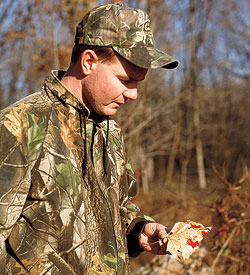October 28, 2010
By John Trout, Jr.
By John Trout Jr.
 The color of first blood can offer important clues about the result of your shot. Bright-colored blood, especially if it contains small air bubbles, typically indicates a lung hit, while dark-colored blood means you probably hit the deer further back in the liver or abdomen. |
Although you often see the arrow hit, or can tell by the deer's reaction where it hit, your blood trail offers another tried and true way to determine the impact location. The color of the first blood you locate should be inspected closely. Bright-colored blood, often with small air bubbles in it, typically indicates your arrow passed through the vital lungs, while dark-colored blood signifies it passed through the abdomen.
First blood is often discovered within a short distance of where the deer was standing when shot. Examining your arrow, particularly when it passes completely through the animal, is another great way to determine what kind of blood you're dealing with.
Advertisement
Stomach, liver and intestinal wounds usually result in blood that is dark red. Exceptions could exist, such as a quartering-to or quartering-away shot. For instance, if the arrow passes through the middle of the abdomen and exits through a lung, you could find bright and dark blood. The same principle applies if the arrow enters forward but exits low in the abdomen of the deer.
You also could locate bright blood if your arrow results in a muscular wound. A superficial muscle wound can appear very similar to a lung shot. An arrow that passes through the heart could cause the blood to appear crimson red -- slightly darker than lung blood, but brighter than blood from an abdominal wound.
Advertisement
Determining blood color accurately is tricky business, but experienced trackers are often able to master this complex endeavor. However, keep in mind that time, weather and terrain could affect the color of blood. Blood that dries or freezes will darken and appear dull. Blood that falls onto soil instead of leaves and other debris also could appear darker. Rain might cause blood to look lighter than it was when it hit the ground.
Blood color is most accurately determined if you can inspect it soon after the shot. Nevertheless, I suggest you never rush picking up the trail. It's always best to wait 20-30 minutes before leaving your ambush site.
